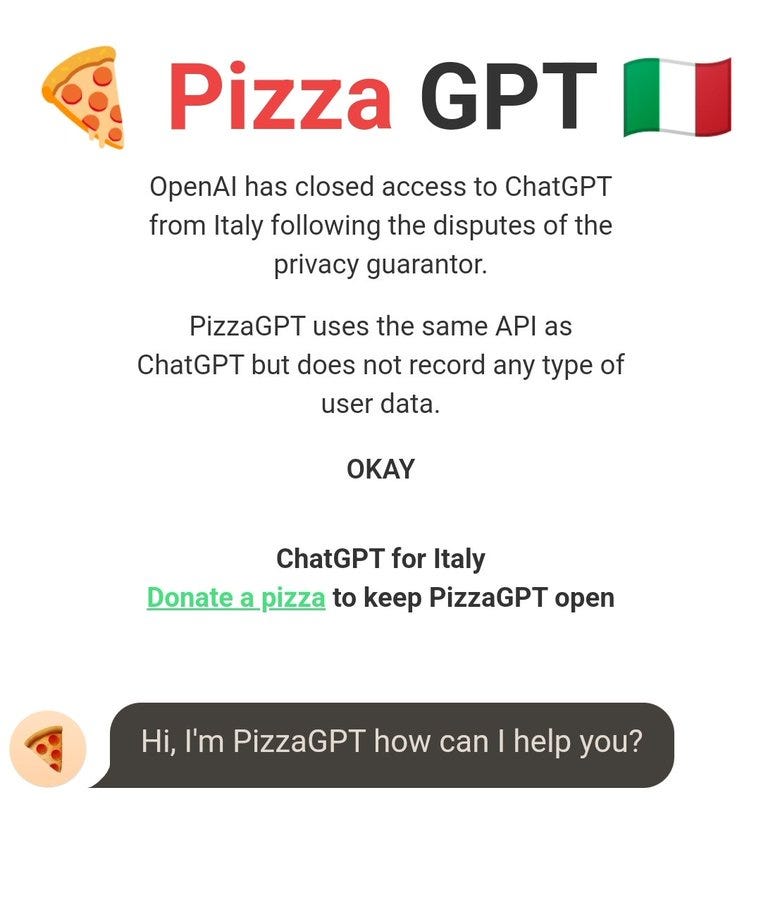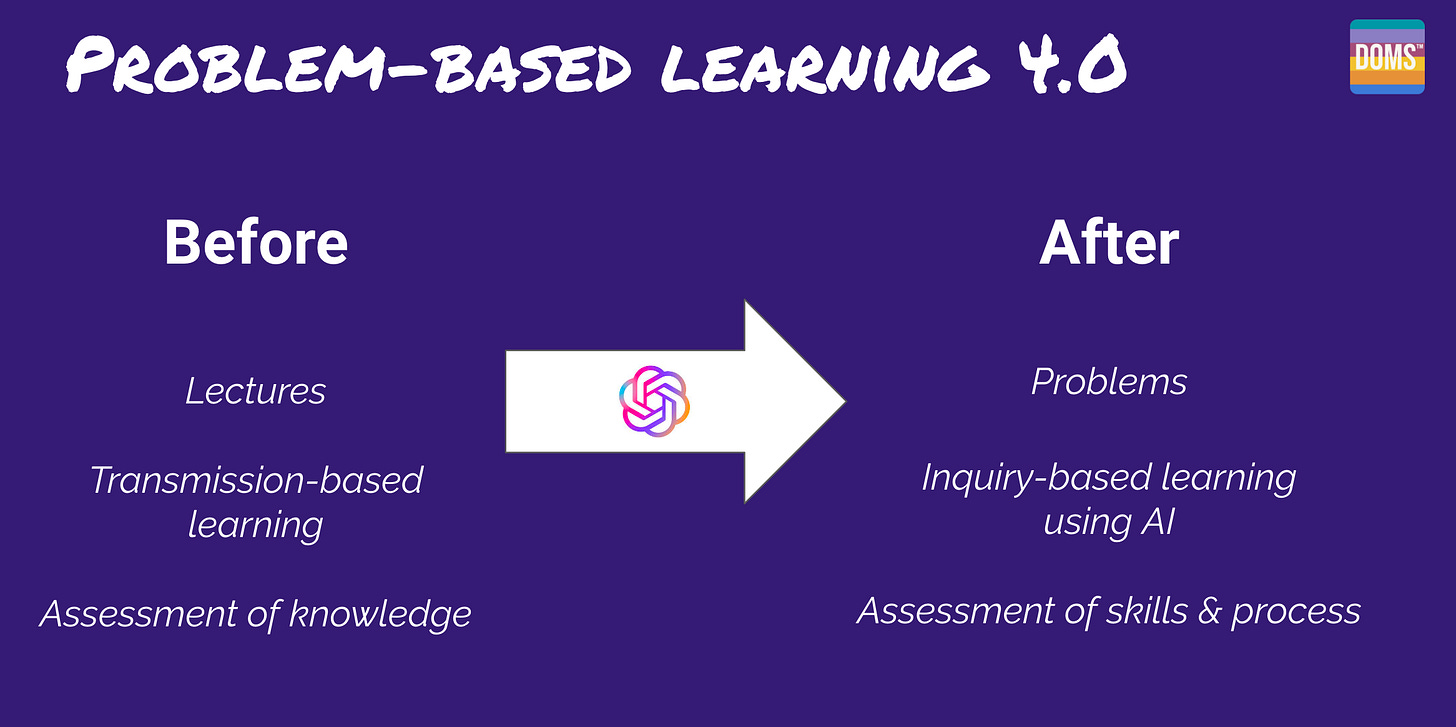AI-detection software isn't the future of education - AI-empowered teaching & learning is.
Embracing AI in the classroom can make us more efficient, effective and relevant as educators, but knowing exactly where to start and how to embrace AI responsibly and effectively is tough.
In this week’s newsletter I’ll share my thoughts on why AI is here to stay and why I think we, as educators, have a responsibility to embrace AI in the classroom.
I’ll also introduce DOMS™️ EDUCATE, a new framework which - I hope - will to make experimentation and the transition to the post-AI classroom easier.
Let’s go! 🚀
ChatGPT is Here to Stay
A question I’be been asked a lot recently is: is ChatGPT here to stay? Is it the equivalent of the printing press or the steam engine which changed how we live and work forever or is it more like Google Glass or Apple’s Newton, which, despite a lot of hype, turned out to be a flash in the pan?
What we know from a small number of controlled studies that have been published in the last month or so is that ChatGPT has already proved that it can to have a significant impact on both human productivity and human performance.
In controlled tests, ChatGPT has proven to be capable of increasing human productivity (i.e. the time it takes to successfully complete a task) by around 35%. To put this into context, the productivity gain of the steam engine in the 19th century was 25%.
In terms of performance, ChatGPT has already proven to be capable of increasing human performance (i.e. the quality of an output) by 5%. Anecdotal evidence from people on the ground suggests that this figure could be closer to 40%.

What we’re witnessing is the rise of a technology which has proven potential to transform the way we live and work.
Based on the data we’ve seen so far, the most likely future is one where generative AI is an integral part of the way we live and work.
In turn, this means that for educators, the most likely future is one where we play a key part in preparing our students to be highly competent and critical consumers of AI technologies like ChatGPT.
Plagiarism & AI: a Cat & Mouse Story
When ChatGPT first came onto the scene at the end of last year, the predominant response in higher ed was one of fear. This fear had three main components:
fear of ChatGPT’s ability to write essays, undermining the vast majority of assessments;
fear of ChatGPT’s so-called “hallucinations” and reliability;
fear of the future: as an educator, what does the rise of AI mean for me and my career?
Perhaps unsurprisingly, both higher ed and K12’s immediate response to the rise of ChatGPT was to to find ways to deter students from using it.
At first, schools did this by developing strict misconduct policies on the use of ChatGPT. Some universities opted to return to pen & paper essays and exams and oral exams under the watchful eye of educators. Other institutions adapted their essay and exam rules to require students to use images and videos which (back then) couldn’t be generated by AI.
Then, in January, many education institutions bolstered their position by investing in box-fresh-to-market AI-detection technologies. Tools like GPTZero and Turnitin AI leveraged the power of AI (the irony) to build machines capable of differentiating between AI-generated texts and texts written by human students.
Job done, right? Wrong.
The rise of AI-detection technology came hand in hand with the rise of counter-technologies which enable students to (again, ironically) use the power of AI to circumnavigate AI detection technologies.
As quickly as tools like TurnitIn AI and GPTZero were built, programmers went to work to build tools capable of beating detection algorithms.
At first these were hacks shared predominantly by YouTubers. Only a couple of months later, we’re seeing fully-fledged products like Conch being brought to market on the promise that they will rewrite your AI-generated essay until it becomes detection free.
Right now, we’re still caught in this strange, unsettling and bizarre cat and mouse chase, where companies like TurnitIn and GPTZero are engaged in daily battle with YouTube influencers and student-facing start-ups like Conch.
A similar battle is also raging outside of the world of education. In April, the Italian government banned ChatGPT over data & privacy concerns. Within 48 hrs, programmers had released “PizzaGPT” - a perfect clone of ChatGPT which reinstated full access to ChatGPT functionality for all users in Italy.
More and more, expert AI commentators like Gianluca Mauro are pointing out that the battle we’re engaged in is futile. Ultimately, perfect AI-detection is simply not possible.
So, what does this mean for education?
Problem-Based Learning 4.0
In the last few weeks we’ve started to see more & more positive experimentation with ChatGPT in the classroom.
A growing number of AI-curious educators have started to ask: what if instead of trying to find ways to stop students from using AI to write essays, we instead embraced AI in the classroom?
What if instead of focusing on plagiarism, we focused on adapting and innovating our pedagogies for a post-AI world?
It’s early days but what we seem to be witnessing so far is the rise of what we might refer to as Problem-Based Learning 4.0.
Problem-based learning (PBL) isn’t new, of course; it first emerged in the 1960s in response to the limited impact of the lecture model on student outcomes.
In recent months, we’ve seen something of renaissance in this approach, as confirmed by a spike in peer-reviewed research on PBL and an increase in more informal experimentation in both K12 and higher-ed.
A lot of this revived interest is driven - of course - by the need to find new ways to assess our students.
In a world where AI can very rapidly write very high-quality, undetectable essays, problem-based learning offers a more “AI proof” approach to teaching and learning by diversifying how we define and assess academic success.
In the post-AI problem-based classroom, students are still assessed on their ability to memorise, recognise, recall and restate reliable factual information, but they are also assessed on the skills, actions and processes they demonstrate in the process of problem solving.
Within this approach, AI tools like ChatGPT take on a new role as a tool and source of information to be critiqued and explored alongside other, more traditional sources and tools like articles and books.
Of course, AI isn’t a perfect source and - like any source, tool and idea - must to be approached with necessary caution and criticality.
But in many ways the flaws and risks of AI are where we find its deepest value. When we integrate AI into our classrooms we hold ourselves accountable as educators to ensuring that our students develop the criticality of thought and action and the skills they need to enable them to contribute positively to their communities, to the economy and to society at large.
Introducing DOMS™️ EDUCATE: a Learning Design Framework for the Post-AI Classroom
On talking to educators about the rise of the AI classroom, one of the biggest barriers to change is a lack of structured information about AI. Among the most asked questions I hear from educators are: What does AI mean for how I design assessment? How do I integrate AI safely and effectively in my classroom? What ethical & privacy risks do I need to understand?
With this in mind, I’ve created and started to test a new framework for the effective integration of AI into the classroom.
DOMS™️ EDUCATE is a seven-step framework which enables educators to integrate AI into their classroom.
EDUCATE provides educators with both a process [what to do] and a methodology [how to do it] to enable them rapidly get to grips with AI and - when they’re ready - integrate it successfully into their classrooms.
The seven steps go as follows:
E - Edit Objectives: how to review & re-write your learning objectives to assess domain knowledge and 21st-century skills, including the use of AI.
D - Design Projects: how to design authentic, open-ended projects which require critical thinking, collaboration & creativity as well as recall of core concepts.
U - Utilise & Assess AI Tools: how to integrate AI into your lesson, including a rubric for assessing the pedagogical & ethical quality of AI-education tools.
C - Create AI-Integrated Assessments: how to design AI-powered formative and summative assessments to check students' knowledge acquisition and their process and skills.
A - Acquire AI Knowledge: how to keep yourself up to date on the ever-changing AI landscape using resources like the AI Now Institute & AI Ethics Lab.
T - Teach AI Methods & Ethics: how to teach your students about AI, using resources like AI for K-12 Initiative & Google AI.
E - Enable Student Inquiry: how to drive student-led inquiry in the AI classroom by encouraging curiosity, developing essential questions, scaffolding the inquiry process and providing the right feedback at the right time.
I’ll share more information about DOMS™️ EDUCATE in the next week or so when my testing is complete. initial thoughts, feedback and questions are - as ever - welcomed.
For now, I’ll leave you with two questions and a quote:
Question 1: Is an education system which fails to embrace AI relevant in a post-AI world?
Question 2: Is an education system which fails to embrace AI delivering on its promise to empower students to contribute positively to their communities, the economy and society at large?
Quote: “You’re not going to be replaced by AI; you’re going to be replaced by someone who knows about AI.” Fei-Fei Li
Happy designing 👋
Phil










